In the face of plummeting insect and bird populations, citizens in many European countries are far more proactive in limiting pesticide use and encouraging farmers to preserve wildlife and meadow habitat. Similarly it is important for people to become aware, be educated and learn that they too can do so on their own property.
I hope that this pollinator program provides the tools to encourage a landscape friendly to all pollinators. It’s important for people to become aware, educated and to know what they can do to help.
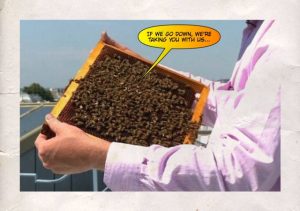
“We’ve all been standing by and watching for too long, now time is running away from us.”
“We’ve all been standing by and watching for too long, now time is running away from us.”
As a Sequim beekeeper and gardener, putting together a planting program to attract beneficial insects and improving habitat for pollinators will be much different for the wetter and fewer heat degree days of the west end. To that end my program for the Peninsula Bee club will not be suitable but will provide some material.
Good landscapes and landscape design must take into consideration climate, soils and garden drainage. After this lengthy snow event I will also try to emphasize trees or shrubs as well as the normal garden annual or perennial. Plant suggestions will concentrate on those that will succeed in the Forks and Clallam Bay area. This will include Natives that have Northwest origins and their hybrid cultivars.
By the same token many species of Olearia, Leptospermum and of course Eucryphia would also do well here. Pretty much anything from New Zealand would be great. The same would be said for native plants of Southern Chile.
A camera is also a good editor of the landscape. In so doing we take a hard look at what we have and hopefully edit out our own mistakes. This shot could be entitled; “In which site would you prefer to stand naked in?” Bees feel the same way.
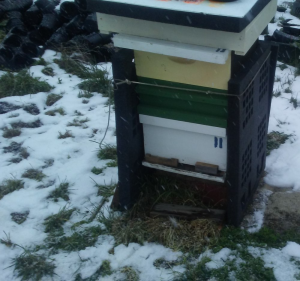 |
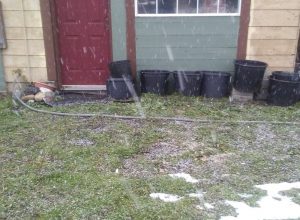 |
Most gardens already have areas that provide food and shelter for pollinators. The easiest thing one can do is identify and expand and protect these spots
A few examples would be:
2. Provide windbreaks and shrubs that flower and provide nectar and pollen. – Wishful thinking here after this winter. A few plant suggestions that come to mind would be Strawberry Tree, Arctic Willow, California Myrtle and the larger but super fragrant Portugese Laurel.
3. Fences and South or East facing walls that can provide nests for Mason bees or beehives.
4. Stone walls, brick or other material that can shelter and host bumblebees and other burrowing bees.
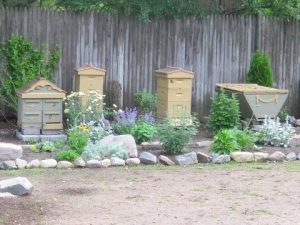 CHANGE YOUR ATTITUDE!
CHANGE YOUR ATTITUDE!
Most important to any apiary or garden that would attract pollinators is the reduction and frequency of mowing. Allow your lawn to grow higher. In many respects that clover or dandelion infested lawn is one of the most cost-effective and miserly of investments you can make. One will also have to deal with the removal of all chemical controls on lawns.
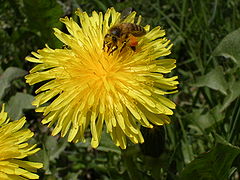
To Re- emphasize.
Let that lawn grow high, let the dandelions bloom and wait to mow until they have flowered but before they set seed. Dandelions are one of the most vital sources of spring food for pollinators – one simply does not mow them down.
Other ‘weeds’ such as blackberries, clovers, thistle, ivy, chickweed, nettle or fireweed all provide food for bees at different times of the year. Consider keeping some of these wild portions as part of your landscape. Cut down and control only before seeds form.
As a local community you can participate in the sharing of plants and collecting native wildflower seed to grow and then share as plugs to be sown in the fall or spring. If you have larger areas, special order the seed in from stores such as Coastal or your favorite nursery. Buy LOCAL, if you can!
BEES and all pollinators need helpful plants in order to survive.
1. In order to prosper they need flowers that produce nectar for energy and pollen for protein. These are equally needed through most periods of the hive.
2. Nature provides the early willow and maple trees to kick start the season and blackberry and other wildflowers have their seasons but you need to provide the glue between those “hunger gaps” the times when there are no natural nectar or pollen rich flowers in bloom. Pollen COLOR chart!
Walnuts are fantastic pollen sources as are filberts.
As a gardener you will also benefit from the healthier pollinization of your own fruit and vegetable crops. The following list of garden plants provide landscape choices that are both colorful, fragrant and attractive while providing the insects with the food they need.
|
Shrubs and Trees |
Bushes and Smaller shrubs. |
Berry/fruiting |
Perennials, Annuals and Groundcovers. |
|---|---|---|---|
|
Native Acer (Maples) and the Cottonwood. |
Berberis – Barberry Cotoneaster – tall and ground-cover |
Blueberries – try new ones such as dwarfs for containers. Huckleberries, |
Frageria Chiloensis (evergreen strawberry) and the coastal Sedum which looks GREAT in pots. 🙂 |
|
All apple varieties, including crab apple |
Deutzia – Hardy Fuchsia |
Currents |
Annuals worth seeking out include Allysum, Clarkia, Cleome, Lobelia, Papaver (Opium Poppy). |
|
Forsythia |
Olearea (Indian Plum) Potentila shrubs |
Gooseberry, Aronia berry |
Vegetable’s. Let some of those heirloom carrots seed! |
|
Hawthorn |
Ribies Sanguineum (Flw. Current) and check out the WHITE form. Rock Rose ** |
Thimble-berry, Salmon berry |
Near all crucifers are great bee plants. Mustard; |
|
Mahonia tall hybrids and the ground-cover ‘Oregon Grape.’ |
Spirea, Specie Roses |
Salal and hybrids such as Gualnettia, – a Pernettia cross – or even a rare alpine Gaultheria. |
Container gardening? Try planting Godetia, Nemesia and Salpigloss as bedfellows. AWESOME! |
|
Ash trees, Laburnum **, Portugese Laurel. |
Viburnum |
Mahonia – Oregon Grape |
|
|
Viburnum |
Manzanita – tall forms and a closeup of the bark. and ground-cover |
Blackberry – check out the new hybrids such as ‘Natchez.’ |
|
|
Wisteria |
Ivy !!! (cut before they seed) |
||
|
Viburnums |
Hebe ** HARDY FORMS only |
||
|
Wild Cherry |
Pernettyia |
||
|
Willow |
Dwarf . Ground cover willows. |
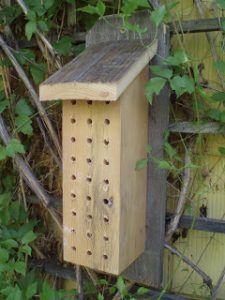 2. Pollinating insects as birds and other wildlife need to have shelter and a stress free home. Proper placement of your Mason bee nests or Apiary are a must. Here are a few suggestions both for wild and domesticated pollinators.
2. Pollinating insects as birds and other wildlife need to have shelter and a stress free home. Proper placement of your Mason bee nests or Apiary are a must. Here are a few suggestions both for wild and domesticated pollinators.
3. Cherish and improve on natural stony hills that may have existing cavities that provide holes for nesting. These can be made with drain bricks, opening up existing holes in a stone wall or by providing bee boxes – which should be cleaned and inspected yearly. Remember as well that native Wild bees including wasps are generally not aggressive unless provoked and can be tremendous assets in killing harmful insects such as aphids. The tiny parasitic wasp is one nest easily made, and they kill aphids like you cannot believe. WASPS are wonderful!
4. When I mentioned ‘stony hills’ I should also stress drainage as amazingly enough one California native that should have died survived the planting. This was a Matiliya Poppy that was planted on top of a gravel bed. Simply put, your efforts to maximize and tailor plants to your property are YOUR decisions. Some will fail and others will succeed. Those that do, will make a large difference to insect populations and may defy ‘plant zone’ wisdom or Nursery advice. The ‘Do not plant there – it won’t live.‘ The fun in gardening is in the experimentation and not going along with the prescribed RULES “The here is where it should be’ ums.’ Gardens should hold surprises, combinations and placements that some might never have tried. EXPERIMENT with something different! – but do pay attention to drainage.
5. The following pictures of some rocky landscapes I did in Sequim also give you the idea what can be done with rock and raised gravelly beds. Remember – try to insert spacers like short bamboo for mining bees. This one took a LOT!
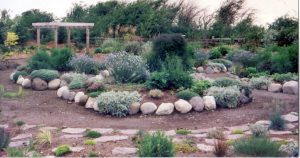 |
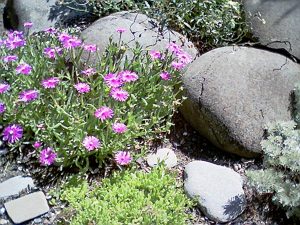 |
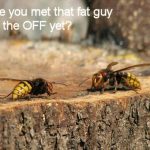
Pesticides are NOT just insecticides but include fungicides and herbicides. Recently a new study shows that the “harmless” Roundup has finally been recognized as significantly increasing cancer rates in humans. What it does to insects is equally toxic. There are very few SAFE insecticides and that includes NEEM oil. This is an excellent link to Bees and pesticides.
All can be harmful to pollinators, either directly, or simply by killing off plants such as milkweed that butterflies depend on or the pollen rich dandelion in the lawn.
Don’t use insecticides on garden flowers and plants and if you do, do so in the late evening and use dermally fast acting products such as a pyrethroid. Most of all WAIT before using anything as soap and water will often rinse off an infestation and quite often, just as you have noticed an infestation of pests, so has nature. Natural predators may already be working on cleaning up the situation at the moment you haul out the bug spray.
Control can also be down by noting pest magnets such as some Artemisia that seem to attract aphids just as your roses come into bloom. Remove the Artemisia and you remove 80 percent of the aphid problem.
Pesticides and fungicides pose an alarming risk when we consider that pesticides
Many seeds and starter plants that you buy are treated with systemic insecticides called neonicotinoid’s. These as well as systemic fungicides when applied to young plants are retained in the pollen and nectar as they mature. This means that honeybees are not only exposed to these chemicals while foraging, but also while feeding the larvae in their hives.
Consistent exposure to this combination of pesticides and fungicides has a major impact on the hive’s ability to fight off disease and parasites. Bayer, now owning Monsanto and Syngenta’s toxic bee-hurting seeds are something that should not be allowed. The same toxicity enters the food chain through the corn.
Ask your nursery to stock plants not so treated. If they cannot provide you with such find another nursery. Many of the seedlings and plants sold in nurseries have been pre-treated with neonicotinoid’s at much higher doses than are used on farms, where levels of this systemic use are already raising concerns among beekeepers and researchers studying the decline of pollinator populations. This is another issue as well.
Companies like Bayer and Monsanto have infiltrated the regulatory agencies both in the UK and in America so previous bans have been overturned. Moreover they use lawsuits and intimidation against organic farmers and the public to get their way. So far it seems to be working.
Don’t use herbicide on your lawn – they (if needed) should become more natural to proved food for pollinators. Weed manually and never use long term – ‘time release’ products. Ask me to follow up on this.
IF you absolutely need to use a herbicide follow the guidelines and spot spray rather than blanket spray the entire area. Not only will you save money, but you will be more effective and safer in doing so. Use a spreader sticker and color dye marker to show where you have sprayed.
1. Never spray during the morning or afternoon. Spray as close to sunset as you can!
2. Do not spray in windy conditions to prevent drift. I see both being done all the time.
3. Always wear full length protective clothing when you do. Not as the ads show, in your shorts and tennis shoes.
KEEP AWAY FROM ELECTRICAL INTERFERENCE

Be it electric power lines, transformers, electric fences, Wi Fi all are detrimental to the bee and if they are suffering declines and collapsing populations just consider that their lifespan may only be 6 weeks. Given time human colony collapse may well affect us come 40 years from now. IMO insects are the canary in the coal mine and when their populations suffer catastrophic declines it bodes a dire health warning for the rest of us. INSECT DECLINE LINK.
The two main reasons for the decline in the bee population may be pesticides but equally so the loss of habitat.
Bee keeping has declined markedly since the fifties and that is a reflection on how farming practices have changed to take measure of short term profit. Gone are the wasted hedgerows, windbreaks and the wildflower buffers between crops of yesteryear. In some states it is estimated that wildflower diversity and acreage has declined by some 90 percent since the thirties.
Even driving through our remaining agricultural plots in Clallam county – mostly east of Sequim one sees that plant diversity is very low in agricultural land. This is the same in CA wine country or in their Apricot monoculture. Bee populations have always been much more stable when diverse sources of pollen and nectar available. How it used to be!!!
It is not surprising that domestic gardens and or landscaped businesses often have more bees and other pollinators than surrounding farms.
Meanwhile, we can get on with the local flowery business of improving habitat starting at home. We can begin doing so by special ordering and then repackaging certain bee friendly seeds. Buy in bulk, or buy from eBay, but such seeds are available.
- Put them into the library seed bank for withdrawal.
- Use them as fundraisers. Doing it in April or May might well become a very popular event.
- Giveaways as promotions, be it a club, restaurant or whatever – doing so will highlight their own sustainability policy and further their eco-credentials.
- Contact your major seed suppliers and ask for donations of past dated seed for this purpose. Germination may be lower but not to a huge degree. This can be done in the Fall.
- Buy bulk clover seed, alfalfa, buckwheat and other legumes from Coastal or local stores and then divvy them out in one pound lots.
Flowers should certainly include borage, phacelia, eschscholzia, poppies, nigella, gypsophila but here is a further list tailored a bit to the climate on the West End.
LATE WINTER and EARLY SPRING GARDEN PLANTS FOR BEES
| Due to the huge variations in climate and conditions in Clallam County, flowering times and rainfall totals differ greatly and this may affect length of foraging as ell as the success or failure of different bee species.
For example, Italian honey bees will forage on crocus flowers, but in cool weather, may be deterred from foraging whereas the Carniolan or Russian Bee will be out. Bumblebees, with their furry insulating coats, often forage on cooler days, meaning that providing for late and very early flowering plants are vital for their survival. |
Galanthus, Winter Aconite, Crocus, Specie tulip and narcissus. Bluebells, primrose, Fritillaria, Winter Honeysuckle, Ajuga, Ivy, Mahonia, Genista, Pulmonaria (Lungwort) Rosemary, ** Winter heathers such as Erica, Hellebore’s (Lenten Rose, Plemonium (Jacob’s Ladder). Willows and that would include shrubs as well as groundcover forms. |
SPRING – SUMMER GARDEN PLANTS FOR BEES
| Many “weed” plants beneficial to bees, such as Milkweed are also beneficial to other pollinators, such as butterflies which are equally threatened with drastic population losses. Good picture of a pollen carrying bee.
During the Spring and Summer, all bees (and other pollinating insects) are rearing their broods and a typical honey bee colony may consist of around 50,000 to 60,000 workers, as well as having larvae to feed. Meaning, they really need to forage to keep the replacement workers alive. Bumblebee colonies are even more fragile – fewer than half survive from one year to the next. Solitary bees are always in need of undisturbed nesting sites, as nectar and pollen is similarly stored to feed developing larvae. Bee friendly plants are therefore vital during the Spring and summer to ensure survival of colonies be they honeybee or native forms. |
Scorpion Weed (Phacelia), Purple Loosestrife !!! WEED, saxifrage, hen and chicks, Sedum, Sweet Peas, Snapdragon, Ajuga, Bergenia, Poppy (Papaver), Chives, Borage officinalis, Crocus, Bergenia, Hellebores, Erigeron |
SUMMER – GARDEN PLANTS FOR BEES
|
During the late summer and autumn, these flowering plants will continue to feed late developing broods, as well as those bees that have already developed into working adults. The local Fireweed would be a major nectar flow plant here. |
Allium, Aquilegia (Columbine), Foxglove (Digitalis), Bistort, Crane’s-bill (Geranium), Poppy (Papaver), Chives, Bugle (Ajuga) Borage officinalis, Summer Crocus, Comfrey, Honey Suckle (Lonicera), Delphinium (Larkspur), Potentilla, Muscari, Thyme, Sedums, Saxifrage, Hen and Chicks, Campanula, Lupin (Lupinus), Rosa rugosa, Sea Holly (Eryngium), Columbine (Aquilegia), Penstemon, Salvia, Hebe, Allium, Agapanthus **, Comfrey, Hardy Fuchisa, Herbs in general |
| Sweet pea (Lathyrus), Lupin (Lupinus), Scarlet Runner Bean |
AUTUMN – WINTER GARDEN PLANTS FOR BEES
|
Ivy (hedera helix) is loathed by many, but it is one of the few plants for bees that aid survival of the late foragers. Cut back as seeds form in February. |
Mint (Mentha), Oregano (Origanum), Autumn raspberries, Mahonia lomarifolia (hybrid forms), Viburnum, Common Heather (Calluna vulgaris), Goldenrod. |
Digger Bees and Carpenter Bees These are also solitary bees, and are good pollinators. Not surprisingly, digger bees usually make their nests in soil. They have hairy bodies, and can be up to 3cm long!
Mining Bees They will not cause any damage, and indeed, mining bees should be welcomed in the garden, as again, they are not only enchanting little creatures, they are also valuable pollinators of plants and flowers. Much more can be learned about these more elusive and beautiful bees by checking out a good book. 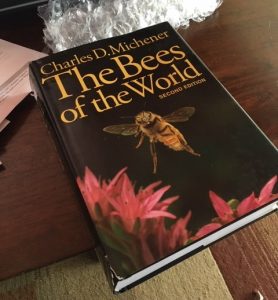
Diatribe on my part as a a person having used pesticides for contracts and having been a licenced pest adviser in CA. Here in Clallam county while doing garden maintenance I cannot begin to mention how often I was driven OFF a job by some wacko next door blithely spraying 2-4 D or worse as if it were lemon juice to be shared by the neighborhood. This while prancing about n short sleeves and shorts.
Same thing with the overuse of Casaron and the pallets worth of dry time release 2-4 D used on lawns in concentrations so high that the residual fumes would drive me away. I have even seen (and complained – years ago!!!) about such materials being sold at Costco right next to meat displays. PALLETS of the fuming bags. Then of course you have Monsanto bragging how safe Round up was – one CEO even drank a cup of it. It would be hard justice that he get the leukemia that it is now linked to.
Is there hope? YES, please read this just passed petition regarding farming in Bavaria.
“We’ve all been standing by and watching for too long, now time is running away from us.” Or the choice is this.

Picture by Greg Butler of NOPBA North Olympic Peninsula Bee Association

I very much enjoyed your writing. I had .17 acre,in Edmonds for 22 years, with a wonderful little garden and lots of bees. Now in east Port Angeles, it is dryer here and I have been developing a mixed, garden since 2019. Cold weather during the plum tree bloom causes, concern. So I will be planting more late winter, early spring pollinators. Besides having a lot of wild flowers I planted from seed, I will continue my policy of no chemicals.
Thank you Janice,
The Nursery has also adapted as well. I am growing more and more pollinator plants including trees. Please check the pages out. Many new tree varieties this year.
Weather always is a factor, but those in wetter spots can always do raised beds or work on soil drainage. There is always a way.
Many years ago (decades) I planted a CA native, Romneya coulteri in Clallam Bay. It thrived!! It also was planted on the top of a gravel bed. I have those in stock now.
We are building a home in Sequim and as we look at landscaping, I want to plant for the region with focus on the best options for pollinators.
Was excited to find your page !